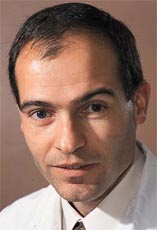|
|
Cognitive Neuro-Rehabilitation Laboratory
SCHNIDER Armin

Current position
Professor of Neurorehabilitation, University of Geneva, Chairman of the Rehabilitation Clinic, Dept. for Clinical Neurosciences, University Hospital Geneva
Research interest
Patients having the syndrome of spontaneous confabulation confuse time and place and act according to memories, which may have justly guided their behavior in the past, but which are inappropriate for ongoing reality. Spontaneous confabulation can be considered a lesion model for how the healthy brain adapts thought to ongoing reality. In a number of clinical and electrophysiological studies, we found that this capacity depends on the anterior limbic system, particularly the posterior medial orbitofrontal cortex, which adapts (filters) the cortical representation of upcoming memories even before their content is (consciously) recognized and again encoded. Our current projects explore the fine functioning of this filter, its potential link with the so-called “reward”-system, and ways to treat patients with spontaneous confabulation. In addition, we use EEG recordings to explore the electrical cortical representation of impaired, as opposed to intact, memories. Imaging studies are made in collaboration with the PET center in Zürich ( http://www.unizh.ch/dmr/ext/nuk/e_funct_brain_imaging.html ), EEG studies in collaboration with the Laboratoire de cartographie cérébrale in Geneva (http://brainmapping.unige.ch )
Selected publications
- Schnider A, Regard M, Landis T. Anterograde and retrograde amnesia following bitemporal infarction. Behavioural Neurology 1994; 7: 87-92.
- Schnider A, Gutbrod K, Ozdoba C, Bassetti C. Very severe amnesia with acute onset after isolated hippocampal damage due to systemic lupus erythematosus. Journal of Neurology, Neurosurgery and Psychiatry 1995; 59: 644-646.
- Schnider A, Gutbrod K, Hess CW, Schroth G. Memory without context. Amnesia with confabulations following right capsular genu infarction. Journal of Neurology, Neurosurgery and Psychiatry 1996; 61: 186-193.
- Schnider A, von Däniken C, Gutbrod K. The mechanisms of spontaneous and provoked confabulations. Brain 1996; 119: 1365-1375.
- Schnider A, von Däniken C, Gutbrod K. Disorientation in amnesia: A confusion of memory traces. Brain 1996; 119: 1627-1632.
- Schnider A, Ptak R. Spontaneous confabulators fail to suppress currently irrelevant memory traces. Nature Neuroscience 1999; 2: 677-681. pdf
- Schnider A. Spontaneous confabulations, disorientation, and the processing of 'now'. Neuropsychologia 2000; 38: 175-185.
- Schnider A, Ptak R, von Däniken C, Remonda L. Recovery from spontaneous confabulations parallels recovery of temporal confusion in memory. Neurology 2000; 55: 74-83. pdf
- Schnider A, Treyer V, Buck A. Selection of currently relevant memories by the human posterior medial orbitofrontal cortex. Journal of Neuroscience 2000; 20: 5880-5884. pdf
- Ptak R, Birtoli B, Imboden H, Hauser C, Weis J, Schnider A. Hypothalamic amnesia with spontaneous confabulations: A clinicopathologic study. Neurology 2001; 56: 1597-1600.
- Schnider A. Spontaneous confabulation, reality monitoring, and the limbic system – a review. Brain Research Reviews 2001; 36: 150-160.
- Schnider A, Valenza N, Morand S, Michel CM. Early cortical distinction between memories that pertain to ongoing reality and memories that don't. Cerebral Cortex 2002; 12: 54-61. pdf
- Schnider A. Spontaneous confabulation and the adaptation of thought to ongoing reality. Nature Reviews Neuroscience 2003; 4: 662-671. pdf
- Treyer V, Buck A, Schnider A. Orbitofrontal-subcortical loop activation during suppression of memories that do not pertain to ongoing reality. Journal of Cognitive Neuroscience 2003; 15: 610-618. pdf
- Murray MM, Michel CM, Grave de Peralta R, Ortigue S, Brunet D, Gonzalez Andino S, et al. The sound and the memory: Rapid, incidental discrimination of visual and multisensory memories. NeuroImage 2004; 21: 125-135. pdf
- Pihan H, Gutbrod K, Baas U, Schnider A. Dopamine inhibition and the adaptation of behavior to ongoing reality. Neuroreport 2004; 15: 709-712. pdf
- Ptak R, Schnider A. Disorganised memory after right dorsolateral prefrontal damage. Neurocase 2004; 10: 52-59.
- Schnider A. Verhaltensneurologie. Die neurologische Seite der Neuropsychologie. Eine Einführung für Ärzte und Psychologen. 2. ed. Stuttgart: Thieme, 2004.
- Schnider A, Mohr C, Morand S, Michel CM. Early cortical response to behaviorally relevant absence of anticipated outcomes: a human evoked potential study. Neuroimage 2007 Apr15;35(3):1348-55.
- lehmann S, Morand S, James C, Schnider A. Electrophysiological correlates of deficient encoding in a case of post-anoxic amnesia. Neuropsychologia 2007 Apr9 45(8):1757-66.
Collaboration
Grants
Address
HUG
Service de Neurorééducation
26 avenue beau-séjour
1211 Genève 14
tel : +41 22 382 3700
fax : +41 22 3823 705
armin.schnider@hcuge.ch
|
